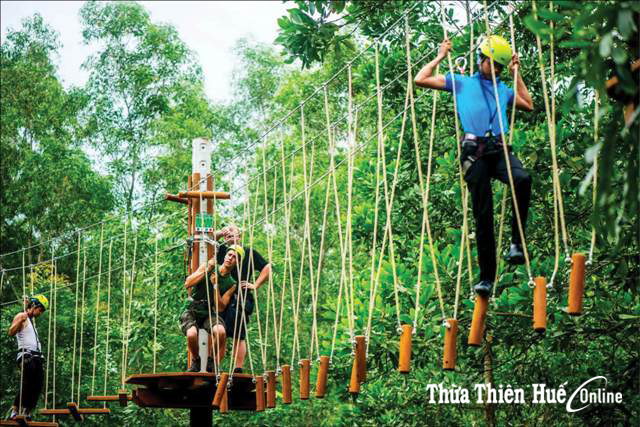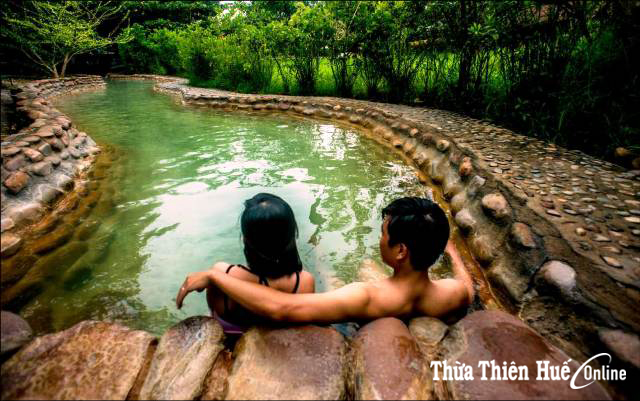As I looked doubtful, he showed me a bunch of test results and a schedule of health examination and treatment. He said that it could be done in Saigon; however, he would have a long and tiring wait. In Hue, the service was good, cheap and fast, and he could also travel around.

Entertainment service at Thanh Tan Hot Springs Resort
Medical travel sounds strange, but it makes sense. Thua Thien Hue has been considered one of the top medical centers in the country. Here, there is almost every efficient medical service. Vietnamese these days usually travel to Singapore or Thailand for treatment. In the world, traveling for medical care is blooming in Istanbul, becoming the non-smoke industry of Turkey, the country located at the three-way crossroad of Europe and Asia.
In 1928, doctor A. Sallet discovered Alba Thanh Tan hot spring at the foot of Ma Yen mountain, Phong Dien district. Alba in Latin means: sunrise, daybreak. In 1957, doctor Fontaine brought some water here to France to examine, the result showed that the mineral water here had the total dissolved solids (TDS) of 860, the highest in Vietnam and the same as the best mineral hot springs in Europe. For the last century, Thanh Tan mineral hot spring has become the destination for medical tourism in Thua Thien Hue

Bathing in Thanh Tan mineral hot spring
Together with Alba hot spring, Thua Thien Hue also has My An hot spring, the water of which is comparable to the water from famous hot springs in the world such as Koundour in Russia or Paven Banis in Bulgaria, according to scientists from Hue University of Medicine and Pharmacy. Like Thanh Tan, My An has become an ideal place for leisure, relaxation and medical treatment for years. I had a chance to go to this tourist site, which is located near the ancient capital. It is designed according to Hue architecture, whichmakes visitors feel very cozy and comfortable when coming here.
Combining tourism and medical treatment has been much mentioned in our province since the Provincial Party Committee promulgated Resolution No.11-NQ/TU to make Thua Thien Hue become the advanced medical center of the central region as well as the whole country in the period of 2012-2015 and to 2020. One of the targets is to complete the restoration of the Nguyen Dynasty’s Royal Medical Institute. On the occasion of review of the ten-year implementation of the Political Bureau’s Resolution No.46 on protection and taking care of people’s health in the new era, former Standing Deputy Secretary of the Provincial Party Committee affirmed the need of renovating the Nguyen Dynasty’s Royal Medical Institute as a place for tourism and medical treatment.
As the capital of the Nguyen Dynasty, Hue hadthe Royal Medical Institute, the national medical center established since Gia Long’s time and completed in Minh Mang’s time. The Royal Medical Institute was a large-scale organization, and it operated effectively and carefully. Its main responsibility was to take care of the king’s health as well as that of the royal family. Moreover, it was responsible for providing the mandarins in the Capital, the people who worked at palaces, temples, tombs, the soldiers and workers at royal construction sites with medical treatment; taking part in fighting against plagues in local areas; opening schools to teach medicine; and advising the Royal Kitchen on cooking for the king as well as the royal family.
The restoration of the Royal Medical Institute to help develop tourism has started from the model of ChineseTong Ren Tang. Tong Ren Tang was stablished in the Qing Dynasty in 1669, and in 1723 it was assigned the responsibility of giving medical treatment to the king and the mandarins, as well as the work of worshiping the founders of medicine. Tong Ren Tang took care of the health of 8 kings of the Qing Dynasty for 188 years (1723-1911). In 1992, at the time of renovation and open door policy, Tong Ren Tang announced the establishment of Beijing Tong Ren Tang Group Corporation. In most of the tours to Beijing, tour guides always take visitors to Tong Ren Tang to listen to the advertisements, have a health check and buy medicine.
There are not many places with great potential to develop medical tourism as in Hue. In addition to the models of combining travel and health care like the hot springs or the Royal Medical Institute, Thua Thien Hue also has many oriental medicine centers such as Tue Tinh Duong Lien Hoa, Tue Tinh Duong Hai Duc, oriental medicine clinics… When coming to get treatment from herbalist Le Quy Nguu’s oriental medicine clinic in An Cuu district, I had a chance to know people from different places; among them were overseas Vietnamese and foreign visitors, coming to Hue for travel as well as for medical treatment. Le Quy Nguu’s reputation has grown beyond our province.
Thua Thien Hue has Hue Central Hospital as the top national medical center and Bach Ma discovered and built by the French 100 years ago, which deserves to become an international tourism-leisure center. Thua Thien Hue also has a complete strategic plan in facilitating the development of medical tourism model. However, what has been done has been slow and not worthy of its potential and scale.
There are 5,000 visitors coming to Turkey each month, mostly to Istanbul, to have hair transplant surgery. In the first 3 months of 2017, Turkey’s income from medical tourism increased by 17%, and the country has set the target of reaching 7 billion dollars in this business this year. In Southeast Asia, Singapore and Thailand have become the top destination for tourists to travel and get medical treatment for more than 10 years, earning billions of dollars each year. These are considered the vivid examples that medical tourism will be the “golden goose” for Thua Thien Hue if it is strongly promoted.
By Dan Duy